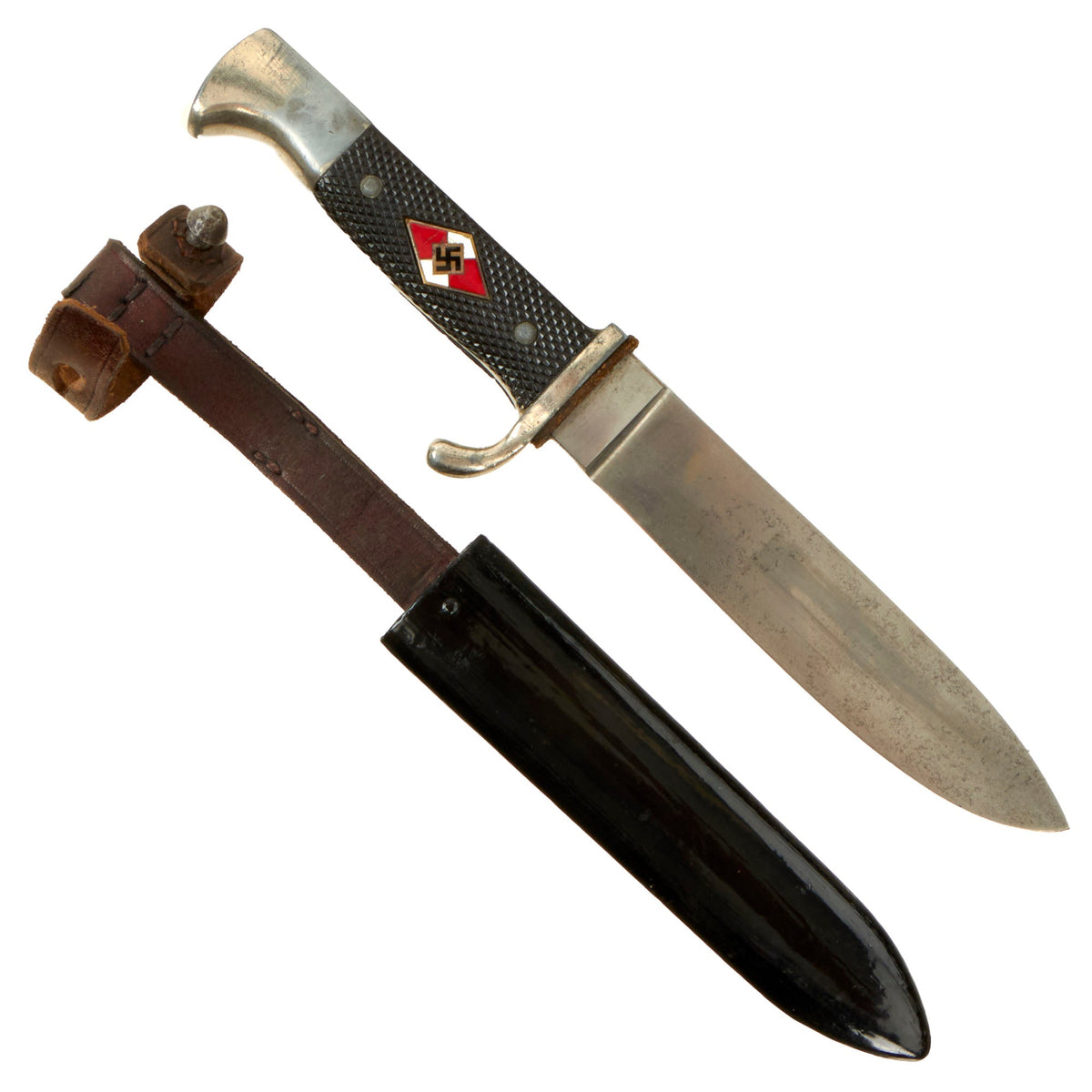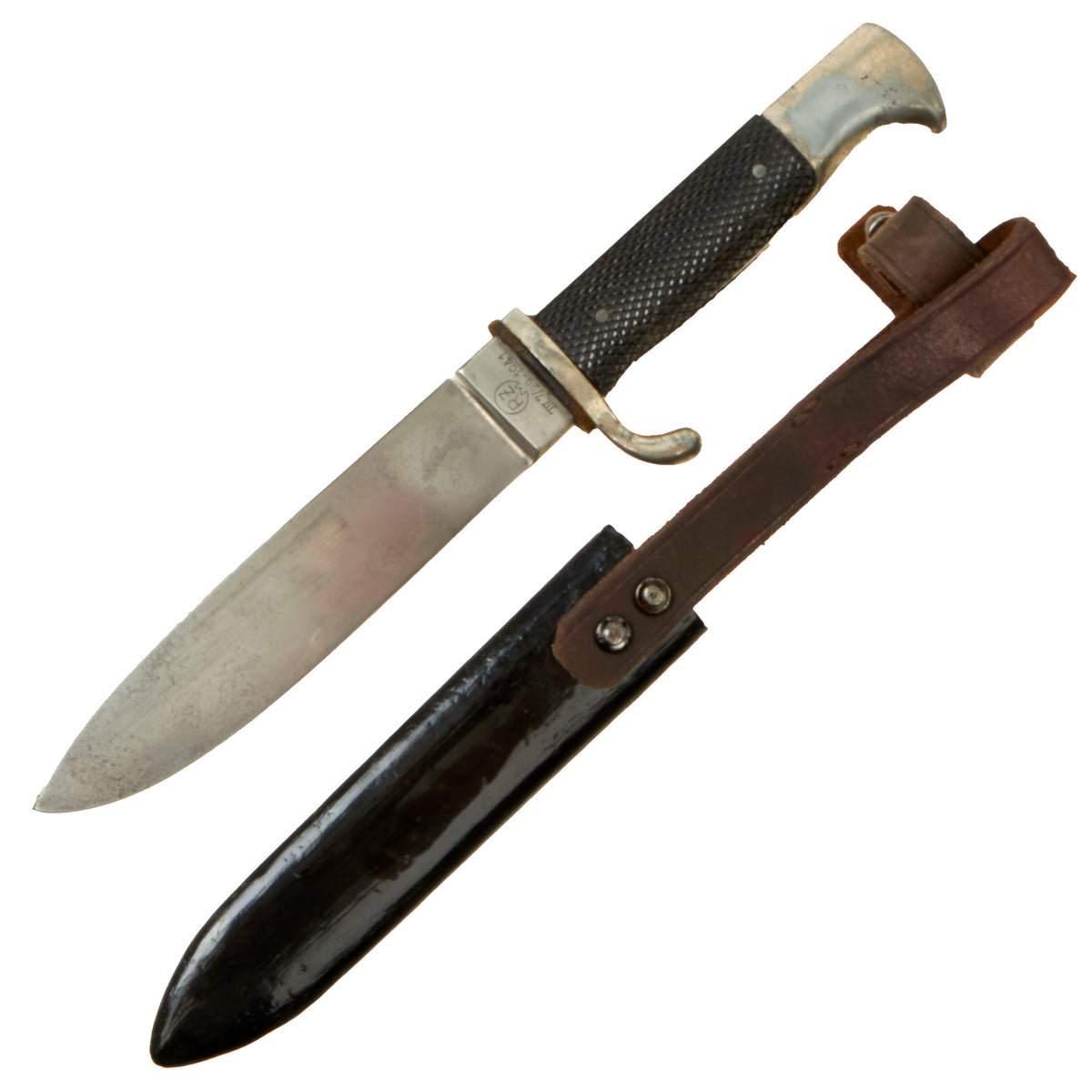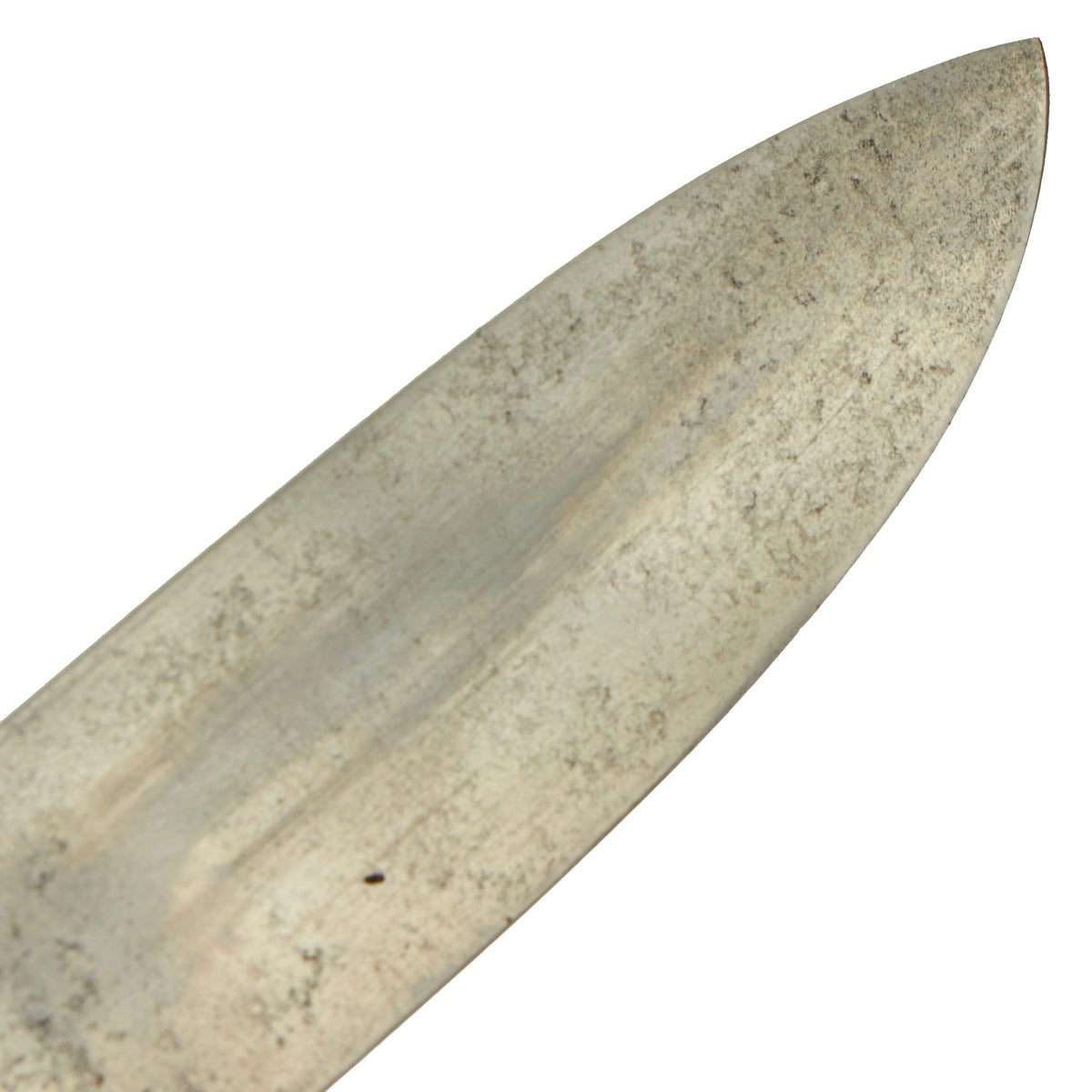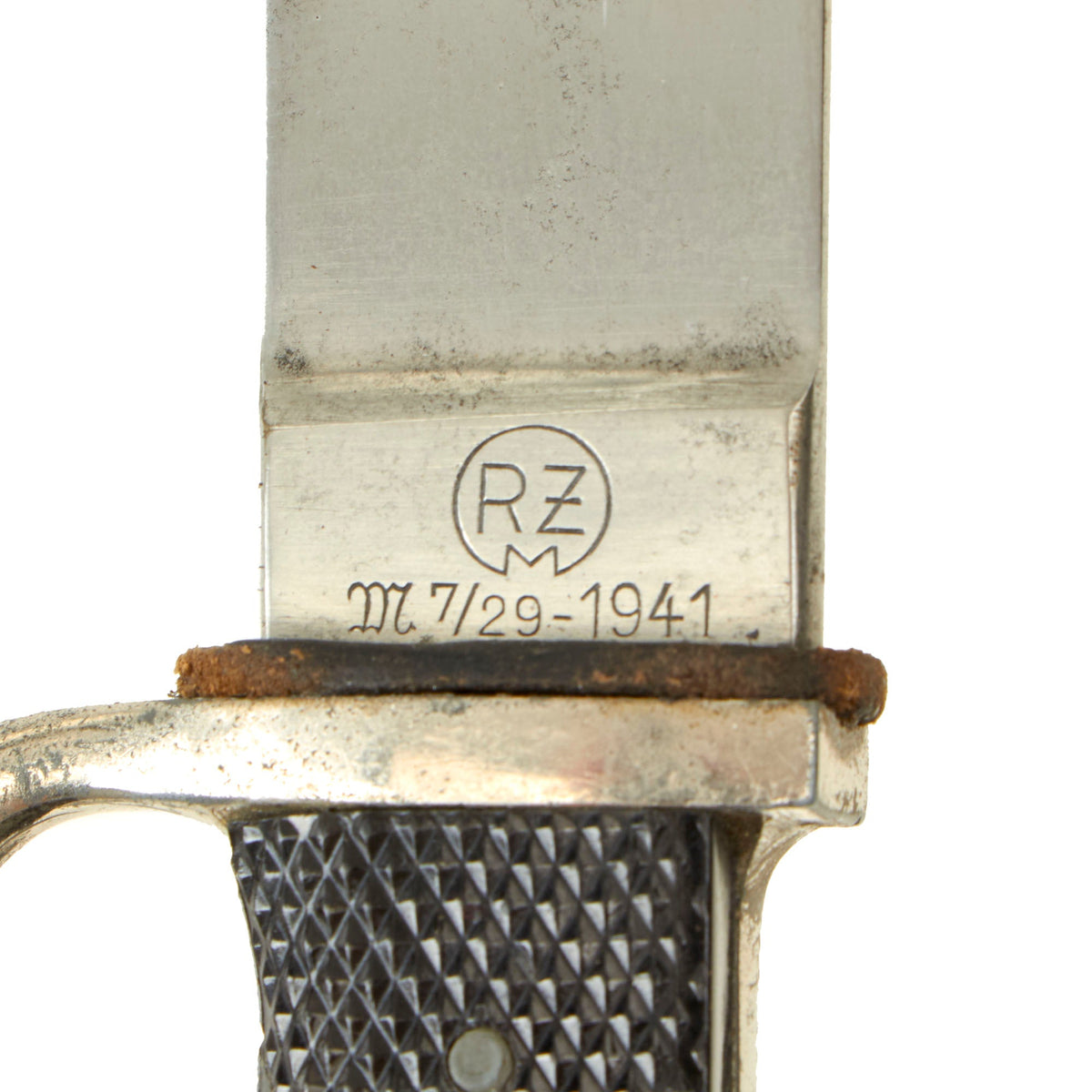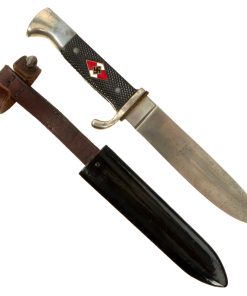Original German WWII 1941 Dated Late Pattern HJ Knife by Rare Maker Klittermann & Moog with Refurbished Scabbard – RZM M7/29 Original Items
$ 595,00 $ 178,50
Original Item: Only One Available. This is an lovely example of the classic later pattern HJ fahrtenmesser (trip knife), produced by the very rare maker Klittermann & Moog GmbH, Rasiermesserfabrik (Razor Factory). This company was located in Haan, right to the west of Solingen, the Legendary “City of Blades” in Germany. They often gave their location as “Haan bei Solingen” to associate themselves with the City, and Haan really was located just outside its outer districts. This company started trading in the early Weimar period, and registered numerous trademarks, and during the Third Reich period began advertising edged weapons in Die Klinge. Per J. Anthony Carter’s fine work GERMAN SWORD AND KNIFE MAKERS, this company made SA and NSKK daggers, as well as edged weapons for numerous other NSDAP organizations, such as the HJ. They were given RZM number M7/29, which previously had been used by Jacobs & Co., so to distinguish their marking they used Fraktur blackletter type for the “M” in the RZM marking.
This is only the second item of any type that we have had from this rare maker, and it comes complete with its original scabbard, which has been refurbished. This entailed a total repaint of the steel shell, and attachment of a new belt hanger. This looks to have been done some type ago, however we do not know if this was during the WWII Period or after.
These knives were given to boys who were educated in the paramilitary organization, which they often continued to carry into their military service. Unlike the early pattern knives, these have a thicker blade with a raised ricasso, which significantly strengthened the blade. They also do not have the HJ motto etched on the blade, and often are marked not with a maker, but a German RZM Code.
The hilt of this example is nickel plated zinc alloy, and the original finish is retained at about 50%, having been worn off by use and the retaining strap on the scabbard. The grip plates are the black checkered bakelite variety and are in very good condition, showing light wear. The left grip scale however does have a repaired crack. They are retained by zinc rivets with dressed obverse heads. The HJ grip insignia has most of the enamel intact, and the brass borders between the panels have lost the original nickel plating, showing an oxidized brass color. The insignia is a bit loose in the grips, caused by the bakelite shrinking over the years, which also confirms authenticity.
The blade of this example is in very good condition, still showing some of the original factory final grind cross grain. This texture is iconic, and is the definitive identifying characteristic for a real WWII German Blade. There is a bit of runner wear, and the blade surfaces do show signs of some past oxidation and staining that was later cleaned away. This has made the cross grain faint. The edge is currently relatively dull, and does not look to have been sharpened much, or at all.
The reverse of the blade is clearly stamped with (RZM) over M.7/29-1941., which has the correct Fraktur font letter “M”. We had a previous example that also had the trademark on the blade, which was made AFTER this example, so it appears that this company varied their style over the war. The original leather blade buffer is still in place against the cross guard, showing light wear.
The Reichszeugmeisterei, or RZM, was based at the Brown house in Munich and NSDAP party headquarters in Berlin. The RZM ensured that the manufacturers of military items were consistent in design, quality of materials and other characteristics of the items. It also defined standards of design, manufacturing and quality and published an authoritative color chart for textiles. The M7 in the code stands for knives/daggers, with Klittermann & Moog GmbH being contractor number 29.
The scabbard shell is the typical tapered example, made from steel, and was repainted with black enamel paint, with the brush texture still visible. At this time it was also fitted with a new belt loop with securing strap, which is in great shape.
A lovely late pattern German WWII HJ Knife from a rare maker with a refurbished scabbard. Ready to display!
Approximate Measurements:
Blade Length: 5 1/2″
Blade Style: Single Edged Knife.
Overall length: 9 5/8”
Crossguard: 1 7/8″
Scabbard Length: 5 3/4” + Belt Loop
HJ believed German youth to be the future of his 3rd Reich. The HJ (jugend) was formed officially in 1935, and with the exception of NSDAP ideology indoctrination was very similar to the Boy Scouts. Beginning at about the age of ten years, both boys (jugend) and girls (Bund Deutscher Mädel) were enlisted in the Party-run organization. The boys only were given HJ Knives after having passed minor exams. The knives had nickeled hilts with black checkered grip plates. The obverse plate was fitted with an enameled HJ swas insignia. Through 1937, these knives were etched with the motto of the organization, Blut und Ehre! (Blood and Honor!). Examples produced after this date were made with plain blades usually bearing an RZM marking.
The HJ Leaders were professionals in charge of the training and NSDAP education of the German Youth. They wore a special dagger consisting of silvered hilt fittings with blue-black leather-covered scabbard. The grip was composed of tightly wrapped silver wire, over a wood base. The pommel cap featured an HJ diamond on top, complete with swas. The upper scabbard fitting portrayed an open-winged HJ eagle with swas cut into the bird’s chest. The blade was etched with the HJ motto, Blut und Ehre!
Fast Shipping with Professional Packaging
Thanks to our longstanding association with UPS FedEx DHL, and other major international carriers, we are able to provide a range of shipping options. Our warehouse staff is expertly trained and will wrap your products according to our exact and precise specifications. Prior to shipping, your goods will be thoroughly examined and securely secured. We ship to thousands clients each day across multiple countries. This shows how we're dedicated to be the largest retailer on the internet. Warehouses and distribution centres can be located throughout Europe as well as the USA.
Note: Orders with more than one item will be assigned a processing date depending on the item.
Before shipping before shipping, we'll conduct a thorough inspection of the items you have ordered. Today, the majority of orders will be delivered within 48 hours. The delivery time will be between 3-7 days.
Returns
The stock is dynamic and we cannot completely manage it because multiple stakeholders are involved, including our factory and warehouse. So the actual stock may alter at any time. It's possible that you may not receive your order once the order has been made.
Our policy is valid for a period of 30 days. If you don't receive the product within 30 days, we are not able to issue a refund or an exchange.
You can only return an item if it is unused and in the same state as the day you received it. You must have the item in its original packaging.
Related products
Uncategorized
Armored Burgonet Helmet & Polearm from Scottish Castle Leith Hall Circa 1700 Original Items
Uncategorized
Uncategorized
Uncategorized
Uncategorized
Uncategorized
Uncategorized
Uncategorized
Uncategorized
Uncategorized
Uncategorized
Uncategorized
Uncategorized
Uncategorized
Uncategorized
Uncategorized
Uncategorized
Uncategorized
Band of Brothers ORIGINAL GERMAN WWII Le. F.H. 18 10.5cm ARTILLERY PIECE Original Items
Uncategorized
Uncategorized
Uncategorized
